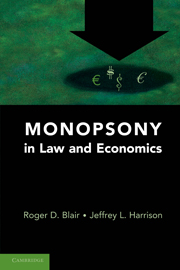Book contents
- Frontmatter
- Contents
- Preface
- ONE Introduction
- TWO The Antitrust Laws and Monopsonistic Forms of Conduct
- THREE Economic Theory of Monopsony
- FOUR The Antitrust Response to Monopsony and Collusive Monopsony
- FIVE Cooperative Buying Efforts
- SIX Bilateral Monopoly
- SEVEN Monopsony and Antitrust Enforcement
- EIGHT Monopsony in Action: Agricultural Markets
- NINE Monopsony in Action: The NCAA
- TEN Monopsony in Action: Physician Collective Bargaining: Monopoly or Bilateral Monopoly
- ELEVEN Final Comments
- Bibliography
- Index
EIGHT - Monopsony in Action: Agricultural Markets
Published online by Cambridge University Press: 05 June 2012
- Frontmatter
- Contents
- Preface
- ONE Introduction
- TWO The Antitrust Laws and Monopsonistic Forms of Conduct
- THREE Economic Theory of Monopsony
- FOUR The Antitrust Response to Monopsony and Collusive Monopsony
- FIVE Cooperative Buying Efforts
- SIX Bilateral Monopoly
- SEVEN Monopsony and Antitrust Enforcement
- EIGHT Monopsony in Action: Agricultural Markets
- NINE Monopsony in Action: The NCAA
- TEN Monopsony in Action: Physician Collective Bargaining: Monopoly or Bilateral Monopoly
- ELEVEN Final Comments
- Bibliography
- Index
Summary
Introduction
This chapter considers the use and possible misuse of monopsony power in the context of agricultural markets. In this regard, we are primarily concerned with structural monopsony. Problems associated with collusion are examined in the next chapter. The typical scenario that we address involves relatively small farms selling to large processors of agricultural products. Whether such a structure is economically inevitable is not clear, but it is the likely result of economies of scale in processing that may not exist at the production stage. In any event, there can be little doubt that there has been significant consolidation on the buying side of agricultural markets. This has clearly resulted in distributive effects to which the antitrust laws are unlikely to respond. This does not mean that there are no negative allocative effects. In fact, every private antitrust plaintiff is concerned with a distributive impact rather than allocative efficiency. Part of the role of modern antitrust analysis is to distinguish cases with only distributive effects from those that have both. This chapter explores this distributive/allocative idea in some detail and examines agriculture-specific legislation that is designed to address monopsony conditions. It suggests that a case-by-case analysis of distributive and allocative impacts is warranted.
The Monopsony Problem
The focus of concerns about monopsony power in agriculture is typically on the actual producers of livestock or farm crops. These producers buy inputs – feed, seed, fertilizer, and so on – from one set of suppliers and typically sell to processors. In some instances, these producers buy from sellers of inputs that have monopoly power and sell their output to processors who have monopsony power. The focus here, of course, is on the second part of this analysis. The usual description that raises concerns is one in which producers are “locked in” or “captive” and cannot realistically respond, at least in the short run, to lower prices offered by buyers. One example is found in the poultry industry. Growers, who actually raise the chickens, make substantial investments in poultry houses in order to grow poultry for integrators, those who process the chickens for resale. Economist Robert Taylor describes the eventual outcome in these terms:
[T]he system can best be described as feudal, with master (integrator) and servant (contract producer). Houses require a huge investment. Four to six houses, which are a full-time job for one person, cost from $500,000 to $1,000,000. Poultry houses generally have a 20–30 year economic life. Poultry houses have no practical alternative use; without a contract, the houses have essentially no salvage value.
The integrator owns the birds and feed, and fully controls the breed, quality of chicks, feed deliveries and quality of feed, timing of chick delivery and time at which birds are processed. The pay system for growers has bonuses for performance, but the integrator determines in large part the ranking of the grower and fully controls computation of performance. Economists call this a tournament pay system, but it is closer to a lottery and, at the whim of the integrator, can be a rigged lottery.
- Type
- Chapter
- Information
- Monopsony in Law and Economics , pp. 172 - 187Publisher: Cambridge University PressPrint publication year: 2010



